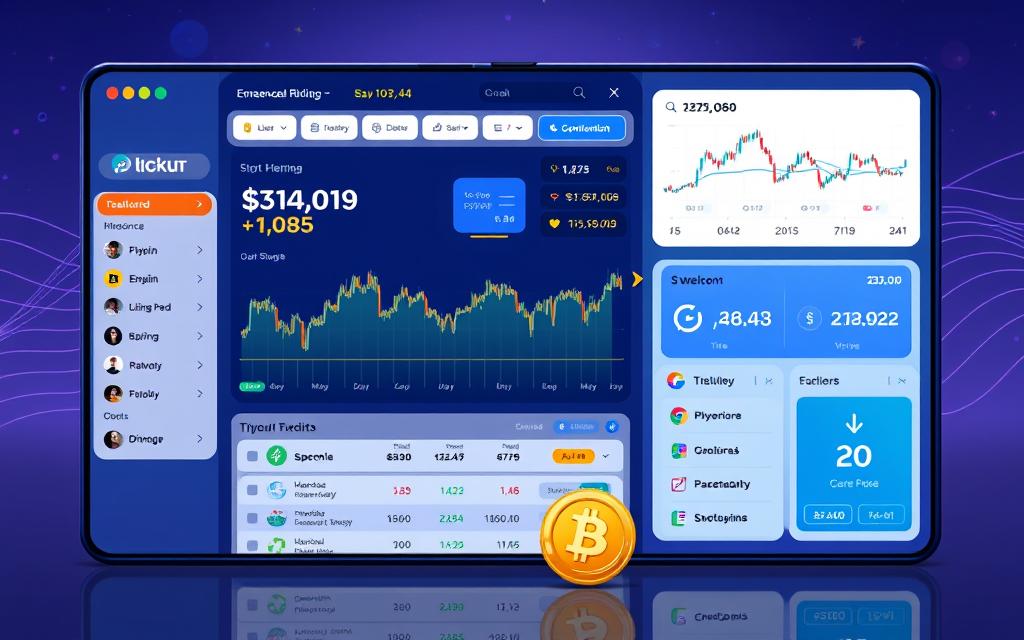Table of Contents
As Bitcoin continues to gain mainstream acceptance and hits new all-time highs, investors are left wondering whether it’s the right moment to invest in the world’s most popular cryptocurrency.
The crypto market in April 2025 presents a mix of opportunities and challenges, with recent price fluctuations making it crucial for investors to assess the current landscape.
This comprehensive guide will examine the current market conditions, historical patterns, and expert opinions to help determine if April 2025 is an optimal time to invest in Bitcoin, addressing concerns about volatility and its place in a diversified investment portfolio.
The Current State of Bitcoin in April 2025
As we enter April 2025, the cryptocurrency market is abuzz with activity, driven largely by Bitcoin’s recent surge. The crypto market has been significantly influenced by recent developments, particularly the outcome of the U.S. presidential election.
Recent Price Movements and Market Trends
Donald Trump’s recent victory in the U.S. presidential election has electrified the market, propelling Bitcoin to a record high of over $93,000. This surge is fueled by heightened expectations for a more crypto-friendly administration. The aftermath of Trump’s policies continues to shape the cryptocurrency landscape in 2025, particularly his administration’s approach to digital asset regulation.
- Institutional adoption has accelerated, with major financial institutions launching new Bitcoin-related investment products and services in Q1 2025.
- Regulatory developments across major economies have created a more defined framework for cryptocurrency operations.
Key Events Shaping the 2025 Bitcoin Market
The performance of spot Bitcoin ETFs has exceeded many analysts’ expectations, drawing significant capital into the cryptocurrency ecosystem. Additionally, Bitcoin ETFs have seen a surge in interest, further bolstered by the anticipation of approval spot Bitcoin ETFs. Key events include Trump’s announcement to buy and hold Bitcoin in the U.S. treasury, which has had a profound impact on the market.
- Technological advancements in the Bitcoin network have addressed previous concerns about Bitcoin’s utility and environmental impact.
- The influence of Donald Trump’s administration on the crypto market has been significant.
Understanding Bitcoin’s Historical Cycles
As we approach April 2025, examining Bitcoin’s past cycles can provide valuable insights into its potential future performance. Historically, Bitcoin’s price has been significantly influenced by halving events, which occur approximately every four years.

The Impact of Previous Halvings on Bitcoin’s Price
Bitcoin halvings have consistently boosted the cryptocurrency’s growth. The anticipated scarcity motivates investors to buy, pushing prices up. For instance, the 2024 halving saw Bitcoin trading at around $65,000 on the event day. However, significant price appreciation occurred months later when it crossed the $100,000 mark.
Post-2024 Halving Performance Analysis
April 2025 marks one year since the fourth halving, a period that historically has shown substantial price movement. On-chain metrics reveal changing holder behavior post-2024 halving, with long-term holders demonstrating stronger conviction. As institutional participation increases, market dynamics differ from earlier cycles, with more sophisticated price discovery mechanisms.
Comparing the current cycle to previous post-halving periods provides context for evaluating whether April 2025 represents a typical phase in Bitcoin’s four-year cycle or an anomaly. According to
“The halving event is a pivotal moment in Bitcoin’s lifecycle, influencing both market sentiment and investor behavior.”
Factors Supporting Bitcoin Investment in 2025
Several compelling reasons are making Bitcoin an attractive investment opportunity in 2025. The cryptocurrency market is witnessing significant developments that are likely to impact Bitcoin’s value and adoption.
Increasing Institutional Adoption and Mainstream Acceptance
The year 2025 is seeing a notable increase in institutional adoption of Bitcoin, with more financial institutions and corporations investing in the cryptocurrency. This trend is coupled with growing mainstream acceptance, as evidenced by the expanding presence of Bitcoin in traditional financial media and its increasing recognition as a legitimate investment vehicle among younger generations.
- Growing investment from institutional investors
- Increasing recognition among younger demographics
- Expanding presence in traditional financial media
Limited Supply and Growing Demand Dynamics
Bitcoin’s fixed supply cap of 21 million coins creates a fundamental scarcity, with approximately 95% already in circulation. The 2024 halving event has further reduced the supply of new Bitcoins entering the market, driving up demand and, consequently, the price.
- Fixed supply cap creating scarcity
- Reduced supply post-halving
- Growing demand driven by adoption and scarcity
Potential Risks of Buying Bitcoin in April 2025
Before investing in Bitcoin in April 2025, investors should be aware of the potential risks and challenges. While Bitcoin has become a more established asset class, it still poses significant risks to investors.
Volatility Concerns and Price Swing Analysis
Bitcoin’s price can be highly volatile, with significant price swings occurring over short periods. This volatility is a major concern for investors, as it can result in substantial losses if not managed properly. Only invest what you’re willing to risk is a common piece of advice for Bitcoin investors. The crypto market’s unpredictability means that investors must be prepared for unexpected changes.

Regulatory Uncertainties and Market Challenges
The regulatory environment for Bitcoin is still evolving, with uncertainty remaining in several key jurisdictions. The Trump administration’s cryptocurrency policies continue to evolve, creating both opportunities and challenges for market participants. Other challenges include tax implications, technological concerns, and competition from central bank digital currencies (CBDCs) and other cryptocurrency projects. These factors can impact Bitcoin’s global adoption and accessibility, affecting its future as an investment opportunity.
Investors must consider these risks and challenges when evaluating Bitcoin as a potential investment in April 2025. The market dynamics and regulatory landscape will play a crucial role in shaping Bitcoin’s prospects.
Is Now a Good Time to Buy Bitcoin April 2025? Expert Perspectives
As we approach the midpoint of April 2025, investors are keenly debating whether it’s a good time to buy Bitcoin. The cryptocurrency market is influenced by various factors, including market trends, investor sentiment, and global economic conditions.
Financial Advisor Recommendations
Financial advisors are advising clients to carefully assess their risk tolerance before investing in Bitcoin. Defining financial goals and understanding the volatility of the cryptocurrency market are crucial steps. If you can handle some risks, Bitcoin may fit into a robust, diversified investment portfolio. Advisors recommend considering the long-term potential of Bitcoin, given its historical resilience and growth patterns.
Market Analyst Predictions for the Remainder of 2025
Market analysts offer divergent price predictions for Bitcoin through the remainder of 2025. Bullish forecasts range from $150,000 to $250,000 by year-end.  Technical analysts point to key support and resistance levels that could influence Bitcoin’s price trajectory. On-chain analysts highlight metrics such as exchange outflows and long-term holder accumulation patterns as indicators of potential price direction.
Technical analysts point to key support and resistance levels that could influence Bitcoin’s price trajectory. On-chain analysts highlight metrics such as exchange outflows and long-term holder accumulation patterns as indicators of potential price direction.
Bitcoin vs. Alternative Investments in 2025
As investors look to diversify their portfolios in 2025, understanding how Bitcoin stacks up against other assets is essential. With its unique characteristics, Bitcoin offers a distinct investment opportunity that can be compared to traditional assets like gold, stocks, and bonds.
Comparing Bitcoin to Gold as a Hedge Asset
Bitcoin and gold have both been considered hedge assets against inflation and market volatility. While gold has a long history as a store of value, Bitcoin’s performance as a hedge is still being evaluated. In 2025, Bitcoin’s correlation with traditional assets continues to be a topic of interest. For more insights on Bitcoin’s forecast in 2025, you can visit Bitpanda Academy for expert opinions and trends.
- Bitcoin has demonstrated different correlation patterns with traditional asset classes in 2025.
- Risk-adjusted return metrics show Bitcoin’s Sharpe ratio compared to major stock indices and bond funds.
Bitcoin’s Performance Against Traditional Stocks and Bonds
When comparing Bitcoin to traditional stocks and bonds, its volatility is a key consideration. Bitcoin’s higher standard deviation of returns relative to stocks and bonds requires appropriate position sizing within a balanced portfolio. Investors should consider the potential returns and the role Bitcoin can play in diversification.
- Volatility comparisons highlight Bitcoin’s higher standard deviation of returns.
- Long-term performance analysis demonstrates Bitcoin’s potential to enhance portfolio returns.
Effective Bitcoin Investment Strategies
As the cryptocurrency landscape continues to evolve, effective investment strategies for Bitcoin are becoming increasingly important. Investors need to consider various approaches to manage the inherent volatility of the crypto market.
Long-Term Holding vs. Market Timing
When it comes to investing in Bitcoin, two popular strategies are long-term holding and market timing. Long-term holding involves purchasing Bitcoin and holding onto it for an extended period, regardless of market fluctuations. This approach requires patience and a strong conviction in Bitcoin’s long-term potential. On the other hand, market timing involves attempting to buy Bitcoin at the right time to maximize returns. However, this strategy can be challenging even for experienced investors, as it requires accurately predicting market movements.

Dollar-Cost Averaging Approach for Bitcoin
Dollar-cost averaging (DCA) is a systematic investment strategy that involves investing a fixed amount of money at regular intervals, regardless of the market’s performance. This approach helps reduce the impact of short-term crypto volatility by spreading out the investment over time. The benefits of DCA include:
- Reduced emotional stress related to market timing
- A disciplined approach to investing
- Potential for lower average costs per unit over time
By adopting a DCA strategy, investors can navigate the complexities of the crypto market in a way that aligns with their financial goals and risk tolerance.
How to Buy Bitcoin in 2025
As we step into 2025, the process of buying Bitcoin has become more streamlined and accessible. With various platforms and investment options available, investors can now easily enter the cryptocurrency market.
Top Cryptocurrency Exchanges and Platforms

When it comes to buying Bitcoin, choosing the right cryptocurrency exchange or platform is crucial. Some of the top exchanges in 2025 offer competitive fees, robust security measures, and user-friendly interfaces. It’s essential to research and compare different exchanges to find the one that best suits your investment needs.
Bitcoin IRAs and Tax-Advantaged Investment Options

For long-term investors, setting up a Bitcoin IRA can provide significant tax benefits. With options like traditional, Roth, and SEP IRAs, investors can enjoy tax-deferred growth or tax-exempt withdrawals. Multiple providers now offer crypto IRAs, with iTrustCapital being one of the top choices due to its transparency and flexibility in combining crypto and gold investments.
- Tax Advantages: Bitcoin IRAs offer tax-deferred growth or tax-exempt withdrawals, depending on the type of IRA.
- Improved Custody Solutions: Enhanced security protocols and insurance coverage protect investor assets.
- Fee Considerations: Setup costs, annual maintenance fees, and trading commissions vary between providers.
- Diversification Options: Investors can hold multiple digital assets alongside Bitcoin in tax-advantaged accounts.
- Regulatory Compliance: Providers have implemented robust KYC/AML procedures and reporting mechanisms.
Conclusion: Making Your Bitcoin Investment Decision
The decision to invest in Bitcoin today hinges on individual financial goals and risk tolerance. As Bitcoin continues to gain worldwide acceptance, its future looks promising. If you’re prepared to stay in the market for a few years, Bitcoin could be a solid addition to your investment portfolio. However, risk-averse investors may prefer traditional assets. A balanced approach considering both potential and risks is essential.
FAQ
What is the current price of Bitcoin and how does it affect investment decisions?
The current price of Bitcoin is subject to significant fluctuations. Investors should consider the spot Bitcoin price and its trends when making investment decisions. Understanding the current market value is crucial for determining the best investment strategy.
How do spot Bitcoin ETFs work and what are their benefits?
Spot Bitcoin ETFs allow investors to buy into a fund that tracks the current price of Bitcoin without directly purchasing the cryptocurrency. This can provide a more traditional investment vehicle for those looking to gain exposure to Bitcoin’s price movements.
What impact does the Bitcoin halving event have on its price?
The Bitcoin halving reduces the supply of new Bitcoins entering the market, which can lead to increased demand and, consequently, a higher price. Historically, halving events have been followed by significant price increases due to the reduced supply.
Is investing in Bitcoin a good strategy for long-term growth?
Investing in Bitcoin can be a viable long-term growth strategy, given its historical performance. However, it’s essential to consider the volatility and potential regulatory changes that could impact its future value.
How does Bitcoin compare to other investment assets like gold and stocks?
Bitcoin is often compared to gold as a hedge against inflation and market downturns. Its performance against traditional stocks and bonds can vary, offering a unique diversification opportunity for investment portfolios.
What are the risks associated with investing in Bitcoin?
Investing in Bitcoin comes with several risks, including price volatility, regulatory uncertainties, and potential market challenges. Investors should be aware of these risks and consider them in their investment decisions.
What investment strategies are effective for Bitcoin?
Effective strategies for investing in Bitcoin include long-term holding and dollar-cost averaging. These approaches can help mitigate the impact of price volatility and timing risks.
How can I buy Bitcoin in 2025?
You can buy Bitcoin through top cryptocurrency exchanges and platforms or consider Bitcoin IRAs for tax-advantaged investment options. It’s crucial to choose a reputable platform that aligns with your investment goals.









